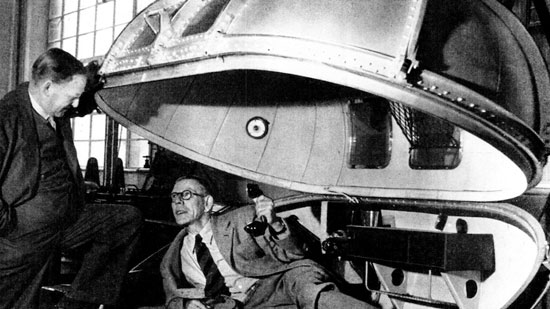Churchill in the News
Churchill and “The Pod”

March 7, 2012
The Internet swarms with rumors (untrue) about Churchill’s pressurized pod.
By Chris H. Sterling for Finest Hour
In January 2012 a website (dvc.com) reported that “C hurchill Used in-Flight Pod to Light up, Stay Alive“. Alas there is much less to this story than the fascinating headline implies.
hurchill Used in-Flight Pod to Light up, Stay Alive“. Alas there is much less to this story than the fascinating headline implies.
Of the many technologies developed during World War II, few were as well-intentioned as a strange device designed to allow Winston Churchill to fly in comfort at high altitudes. Churchill’s doctor, Lord Moran, was concerned that if the Prime Minister flew above about 8000 feet, the lack of oxygen would be bad for his heart. Aircraft pressurization—something we take for granted today—was in its very early stages then. None of the aircraft in which Churchill flew before 1945 was pressurized—thus they generally flew below 8000 feet, save for momentary ventures higher to avoid mountains.1
Flying higher was not only be safer but more comfortable: there is less turbulence above, say, 20,000 feet. As much to the point, anti-aircraft guns of the period began to lose value as airplane altitudes increased. Thus the wizards at the Institute of Aviation Medicine (part of the Royal Aircraft Establishment at Farnborough, west of London) sought a means of allowing the Prime Minister to fly at greater altitude.
As Churchill’s Avro York transport Ascalon was coming into service in mid-1943, IAM technicians created what Jerrard Tickell called “a transparent, sarcophagus-like container inside which Mr. Churchill was expected to repose, work, smoke and sleep in flight. It was pressurized and had an elaborate intercom system.”2 Made of aluminum, it featured eight clear plastic windows to reduce claustrophobia. The device could retain the air pressure of 5000 feet, thought to be safe enough for Churchill. But when the assembled pod turned out to be too large to fit into Ascalon’s fuselage without dismantling the airplane, it was rejected out of hand.
A year later, as the finishing touches were being put into Churchill’s larger VIP transport, an American C-54 (military version of the DC-4 airliner), the pod reappeared—briefly. While it would (just) fit into the larger (but still unpressurized) airplane, it was rejected as too heavy to be practical.3
Churchill never used the pod designed for his use, though many postwar referencs, lately on the Internet, suggest that he did.4 Nor do we know what happened to it.
Endnotes
1. For background on Churchill’s wartime air travel and aircraft, see Christopher H. Sterling, “Getting There: Churchill’s Wartime Journeys,” Finest Hour 148 (Autumn 2010), pp. 10-17.
2. Jerrard Tickell, Ascalon: The Story of Sir Winston Churchill’s War-time Flights, 1943-1945 (London: Hodder & Stoughton, 1964), 79.
3. “Anglo-American Skymaster,” Flight (29 November 1945), 581-84.
4. “Random Fact: Churchill Used in-Flight Pod to Light up, Stay Alive,” (January 2012).
Subscribe
WANT MORE?
Get the Churchill Bulletin delivered to your inbox once a month.






